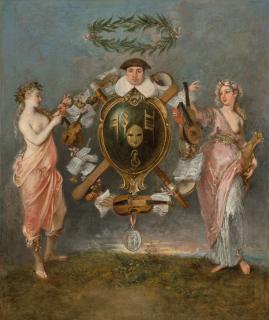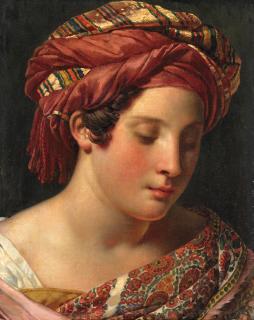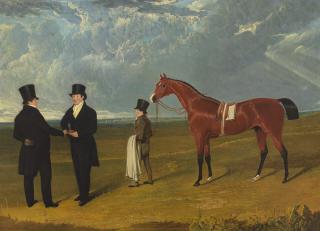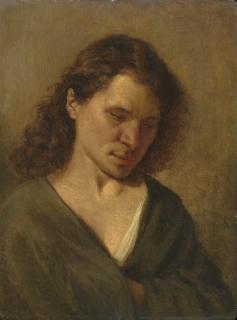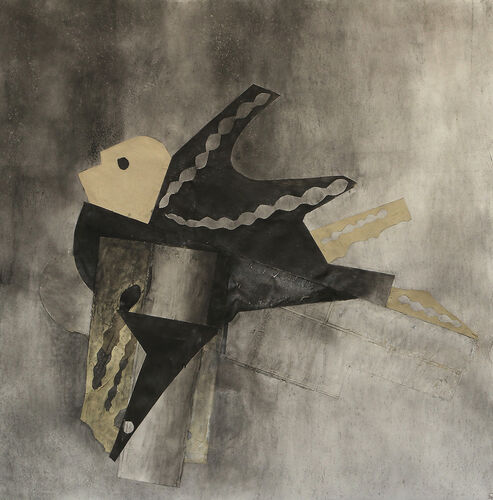- Art.Salon
- Artists
- Jean-Auguste-Dominique Ingres
- Étude pour le Christ Enfant du Vœu de Louis XIII de la cathédrale de Montauban
Jean-Auguste-Dominique Ingres
Étude pour le Christ Enfant du Vœu de Louis XIII de la cathédrale de Montauban
Estimate: 60.000 - 100.000 EUR
Price realised: 94.500 EUR
Price realised: 94.500 EUR
Description
JEAN-AUGUSTE-DOMINIQUE INGRES (1780-1867), STUDY FOR THE CHRIST CHILD OF THE VOW OF LOUIS XIII IN MONTAUBAN CATHEDRAL, OIL ON CANVAS, PEN AND BROWN INK, GRAPHITE
Commissioned by the Ministry of the Interior following 'glowing comments' from Charles Thévenin (1764-1838), director of the Académie de France in Rome, Ingres (1780-1867) produced Le Vœu de Louis XIII while in Florence in the early 1820s (A. Dor, Le Vœu de Louis XIII de la cathédrale de Montauban : restauration et histoire matérielle d'une œuvre d'Ingres, Toulouse, 2018, p. 10), and presented it at the Salon of 1824. This event, of which Stendhal (1783-1842) said: 'we are on the eve of a revolution in the fine arts', saw the proponents of Romanticism and Classicism clash ('Salon de 1824', in D. Massonnaud, Le Nu moderne au salon (1799-1853) : Revue de presse, Grenoble, 2005 [online]). Now housed in Montauban Cathedral, the painting was part of a vast government policy to get contemporary artists to decorate places of worship in France. The presentation of the work was meticulously prepared and met with great success at the Salon, opening the doors of the Académie des Beaux-Arts to the Montauban-born artist the following year.
Ingres, whose initial intention was to depict the Assumption of the Virgin, modified his project to comply with the demands of the local authorities and sponsors. Although he was instructed to depict the Dream of Louis XIII, the painter essentially combined the two compositions, one of which was more important to him. In 1821, he wrote to his friend Jean-François Gilibert (1783-1850): 'I have never thought of not painting the Assumption, which is the centrepiece of the picture' (A.-J. Boyer d'Agen, 'Le vœu de Louis XIII : lettres inédites', La Revue hebdomadaire, 10 July 1909, 28, p. 253).
Our study is the fruit of the painter's extensive research to perfect the central element of his composition. Having hesitated to depict the Christ Child seated, as originally planned in the preparatory drawings, Ingres opted for a representation that emphasised maternal tenderness. The painting in the Josefowitz collection marks another intermediate stage before the final composition, as can be seen from the gesture of blessing, which was not repeated in the Montauban painting. The work presented here, of which a further sketch exists in the Musée Bonnat-Helleu in Bayonne (inv. no. 2236), is ‘the fruit of his constant study of Italian art, where these kinds of anachronistic subjects abound', matured during his stay in Italy. Drawing on the Raphael’s iconographic corpus, Ingres 'spares nothing to render the Raphaelesque thing' in the various elements of his composition (H. Delaborde, 1850, op. cit., p. 178). The study from the Josefowitz collection bears witness to the creative process of a work that marked a fundamental milestone in Ingres's career, confirming him as an artist recognised by critics and his peers.
Commissioned by the Ministry of the Interior following 'glowing comments' from Charles Thévenin (1764-1838), director of the Académie de France in Rome, Ingres (1780-1867) produced Le Vœu de Louis XIII while in Florence in the early 1820s (A. Dor, Le Vœu de Louis XIII de la cathédrale de Montauban : restauration et histoire matérielle d'une œuvre d'Ingres, Toulouse, 2018, p. 10), and presented it at the Salon of 1824. This event, of which Stendhal (1783-1842) said: 'we are on the eve of a revolution in the fine arts', saw the proponents of Romanticism and Classicism clash ('Salon de 1824', in D. Massonnaud, Le Nu moderne au salon (1799-1853) : Revue de presse, Grenoble, 2005 [online]). Now housed in Montauban Cathedral, the painting was part of a vast government policy to get contemporary artists to decorate places of worship in France. The presentation of the work was meticulously prepared and met with great success at the Salon, opening the doors of the Académie des Beaux-Arts to the Montauban-born artist the following year.
Ingres, whose initial intention was to depict the Assumption of the Virgin, modified his project to comply with the demands of the local authorities and sponsors. Although he was instructed to depict the Dream of Louis XIII, the painter essentially combined the two compositions, one of which was more important to him. In 1821, he wrote to his friend Jean-François Gilibert (1783-1850): 'I have never thought of not painting the Assumption, which is the centrepiece of the picture' (A.-J. Boyer d'Agen, 'Le vœu de Louis XIII : lettres inédites', La Revue hebdomadaire, 10 July 1909, 28, p. 253).
Our study is the fruit of the painter's extensive research to perfect the central element of his composition. Having hesitated to depict the Christ Child seated, as originally planned in the preparatory drawings, Ingres opted for a representation that emphasised maternal tenderness. The painting in the Josefowitz collection marks another intermediate stage before the final composition, as can be seen from the gesture of blessing, which was not repeated in the Montauban painting. The work presented here, of which a further sketch exists in the Musée Bonnat-Helleu in Bayonne (inv. no. 2236), is ‘the fruit of his constant study of Italian art, where these kinds of anachronistic subjects abound', matured during his stay in Italy. Drawing on the Raphael’s iconographic corpus, Ingres 'spares nothing to render the Raphaelesque thing' in the various elements of his composition (H. Delaborde, 1850, op. cit., p. 178). The study from the Josefowitz collection bears witness to the creative process of a work that marked a fundamental milestone in Ingres's career, confirming him as an artist recognised by critics and his peers.















